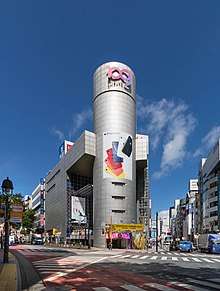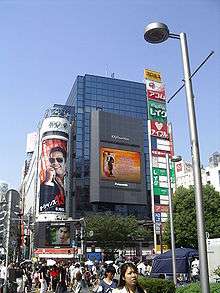109 (department store)
109 (Ichi-maru-kyū) is a department store in Shibuya, Tokyo, Japan. The store is operated by Tokyu Malls Development (TMD), a subsidiary of the Tokyu Group.


History and description
The building, located just across the street from Shibuya Station, opened in April 1979. The architect was Minoru Takeyama. Tokyu, the building's operator, designed the building as a "Fashion Community" containing small retail stores targeting the early-30s female consumer. Tokyu intended the store to compete with Seibu Department Stores, which was making inroads into the Shibuya area.[1]
The name of the building, 109, is a form of word play (goroawase, specifically numerical substitution) and is taken from the Japanese characters tō (meaning 10) and kyū (9) as in Tōkyū. The interior of the building is designed to move shoppers in a loop on each floor from the elevators past various shops. A movie theater was originally planned for the top floor, but the fire department would not grant approval due to emergency-evacuation routes not meeting appropriate standards. Although originally targeted at women in their 30s, the building later became more known as a sanctuary for young women from the gyaru subculture.[1][2]
The original emoji set from SoftBank Mobile (as used by iOS prior to the Unicode emoji standardisation) included one for Shibuya 109, ![]()
Stores
- Shibuya 109 (Shibuya, Tokyo) - April 1979
- 109Men's (Shibuya, Tokyo) - April 1979
- Kohrinbo 109 (Kanazawa, Ishikawa) - September 1985
- 109 Machida (Machida, Tokyo) - July 2002
- Shizuoka 109 (Shizuoka, Shizuoka) - October 2007
- Created in March 2006 as Shibuya 109 Dreams, later recreated into the current 109.[4]
- Minatomirai 109 (Yokohama) - April 2010
- Shibuya 109 Abeno (Osaka) - April 2011
References
- "SHIBUYA109 東京ガイド" (in Japanese). Archived from the original on 14 December 2007. Retrieved 2008-01-24.
- "109Watch" (in Japanese). Archived from the original on 2008-04-12. Retrieved 2008-01-24.
- "Elastic" (in Japanese). Archived from the original on 27 January 2008. Retrieved 2008-01-24.
- Bull, Brett, "Decades as Tokyo's tower of girl power", Japan Times, January 22, 2009, p. 17.
- Nagata, Kazuaki, "Shibuya 109 eyes rebound: Fashion landmark wants to make last year's sales drop a mere blip", Japan Times, May 14, 2010, p. 7.
- Emojipedia. "Shibuya Emoji". Emojipedia.
- "「SHIBUYA109ドリームス」静岡にオープン" (in Japanese). Retrieved 2008-01-24.
External links
| Wikimedia Commons has media related to 109 (department stores). |
- Official website (in English, Chinese, Japanese, and Korean)
- 109Men's (in Japanese)
- Kohrinbo 109 (in Japanese)
- 109 Machida (in Japanese)